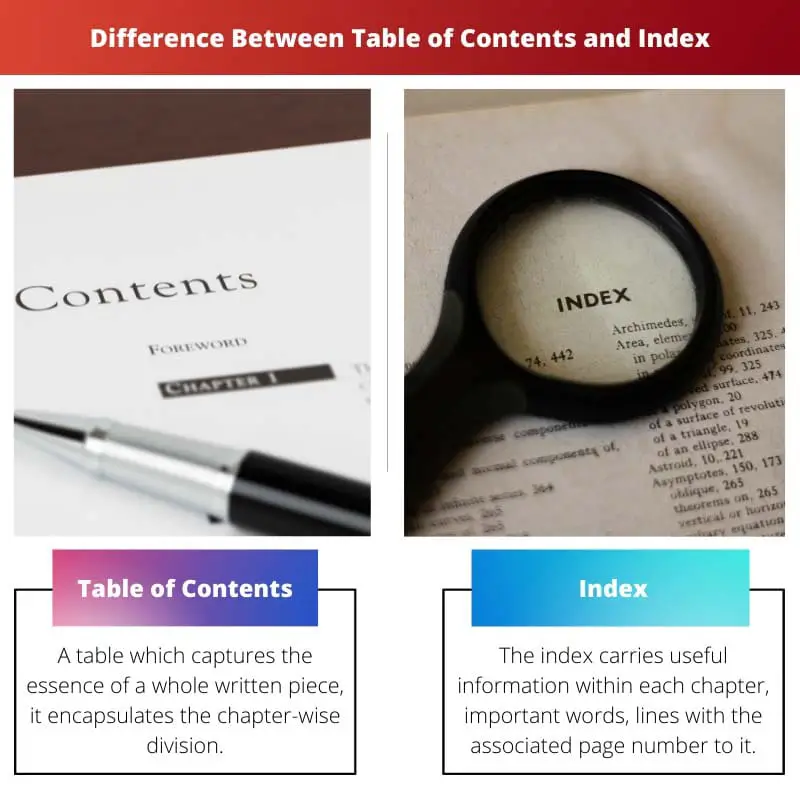Writing and publishing a piece is a process that requires the writer to put effort into making a readable compilation. A written piece of information goes through a lot of editing.
Every single page is arranged to make sense; with so many pages, chapters, titles, and words, the arrangement is all that plays a role. An average document/novel or a professional differs in content and formatting.
Keeping a reader engaged and helping him read without difficulty finding what he wants to search for makes a content table and an index a requirement. “Don’t judge a book by its cover,” they say, and it’s apt.
One can judge a book by its content; the chapters can easily be analyzed through just a page of content or an index. This table of contents and index provide a road map to a reader and help the writer understand if he is missing a part.
Key Takeaways
- A table of contents is a list of chapters, sections, or headings in a document or book, found at the beginning, providing an overview of the document’s structure and organization.
- An index is an alphabetical list of names, subjects, or terms found at the end of a book or document, with corresponding page numbers, used to locate specific information within the text.
- Both the table of contents and index serve as navigational tools in documents or books, but the table of contents offers an organized view of the content structure. In contrast, the index allows for the accessible location of specific information based on keywords or topics.
Table of Contents vs. Index
A table of contents is a list of major sections of a document, located at the beginning and structured hierarchically, with main sections listed first, followed by subsections. An index is a list of specific terms, concepts, topics, and page numbers to help readers find information or topics of interest.

Comparison Table
| Parameter of Comparison | Table of Contents | Index |
|---|---|---|
| Definition | A table that captures the essence of a whole written piece encapsulates the chapter-wise division. | The index carries useful information within each chapter, important words, and lines with the associated page number. |
| Location | It’s at the beginning, after the cover and the title page. | The index is always in the end, so it doesn’t interfere with the book’s flow but helps as a guide whenever required. |
| Requirement | Written material should be more than 10 pages to have a content table. | There are no specific requirements to have an index list. |
What is Table of Contents?
Table of contents (written just ‘Contents’ in a book or a document) is a page, in some cases consisting of 2 pages, which contains the information of the sections the book is divided in. It is a list of the chapters covered with their commencing page numbers placed at the very beginning of the book before the chapters just after the book title and the necessary details like copyright notices, in some cases, the abstract.
In a book containing different authors, the names appear in the table and help the reader consume the content they prefer. The arrangement is based on the chronology the writer has set and is independent of the alphabetical sequence.
It helps to understand the book’s quality and whether it’s worth trying; it organizes the parts and even helps the writer know the parts missing or uncovered topics. In the online content table, one can easily reach the page associated with the required chapter that is just a click away.

What is Index?
The index is a record list of details required to help the reader understand the written material better. It acts as a guide to simultaneously find that particular topic without giving the effort of reading it whole. A quality index should provide an easy key to finding topics and understanding references or terms concerning the page number.
It’s at the end of the book and doesn’t interfere with the flow and sequence. It can be easily accessed by turning all the pages.
The information is arranged sequentially; all the parts are alphabetically arranged and cover each central part within the chapters in the content table. The index can vary in length and depends on the size and the number of pages.
Ideally, 4-6% of the book pages are considered a good length for an Index. There are many guidelines while forming an index. Thus, many people hire an indexer.
Some of the important ones are :
- One should work on an index only once the document or a book is completely edited.
- The information must be precise.
- Use of lowercase letters and nouns that the reader would likely search.

Main Differences Between Table of Contents and Index
- The main difference between the Table of Contents and an Index is that the table of contents consists of main headings, titles, and associated page numbers. In contrast, an Index briefly lists each chapter’s key elements, essential words, concepts, etc.
- The table of Contents is found at the very beginning before any chapter; however, Index is kept at the end.
- A minimum of 10 pages is required to form a content list. Technically, one can skip if the material is less than 10 pages, but Index is required despite the pages.
- The content table follows no alphabetical order as it just contains the sequence in which the author has written it; an index is independent of the content list and follows an order.
- The table of contents doesn’t exceed 2 pages, whereas an Index can be long and detailed.

- https://ieeexplore.ieee.org/abstract/document/1612948/
- https://ieeexplore.ieee.org/abstract/document/1234052/

I enjoyed reading about how the process of writing and publishing a piece is so complex. It’s interesting how an average document differs in content and formatting from a professional one.
I agree with you. The content table and index really do function as roadmaps for readers. They help a reader find what they need and guide the writer to any missing parts.
The details about what a table of contents and an index are, along with their differences, are quite thorough and informative. It’s helpful to have such clarity on these important elements.
I couldn’t agree more. The information provided gives a comprehensive understanding of the significance of both the table of contents and index in written material.
The detailed information about the table of contents and the index is incredibly informative. Understanding their differences and unique roles enhances the appreciation for these critical components in written works.
I couldn’t agree more. The depth of information presented sheds light on the significance of these navigational tools in written pieces.
Absolutely! The nuances of the table of contents and the index are crucial in comprehending their impact on the organization and accessibility of written material.
The details about the table of contents and the index are comprehensive and insightful. This article navigates through their roles adeptly, enhancing the understanding of their contribution to written materials.
I couldn’t agree more. The in-depth analysis of the table of contents and index thoroughly conveys their relevance and impact on the readability and organization of written pieces.
Absolutely! The clarity this article provides on the roles and functions of the table of contents and the index is truly commendable.
The comparison and detailed explanations of the distinctions between the table of contents and the index are enlightening. Understanding their unique functions enriches the comprehension of their significance in written works.
Absolutely! The extensive elucidation of the table of contents and the index amplifies the awareness of their indispensable roles in structuring written content.
Indeed! This article offers a comprehensive and insightful exploration of the roles and importance of both the table of contents and the index in ensuring the coherence and accessibility of written works.
The table of contents and the index are indispensable parts of any written piece. They help the writer keep the content organized and help the reader locate information effectively.
Absolutely. They provide a clear structure for the document or book and make it easier for the reader to navigate through the content.
I found the comparison between the table of contents and the index quite enlightening. It’s interesting to see how they serve different navigational and organizational purposes.
Yes, it’s fascinating to understand the distinct roles of the table of contents and index in guiding readers through a written piece.
The insights into what a table of contents and an index are, as well as their distinctive features, are incredibly enlightening. It’s essential to recognize their pivotal roles in the structure of written content.
Absolutely! This article provides a comprehensive understanding of the significance of the table of contents and the index in ensuring the coherence and accessibility of written works.
I think the explanation of what a table of contents is and what an index is provides a clear understanding of their roles in written material.
Definitely! It sheds light on how both tools contribute to the overall structure and accessibility of the content.
The in-depth explanation of the table of contents and the index is immensely valuable. It highlights their essential roles in ensuring clarity and accessibility for both writers and readers.
Absolutely! The details provided bring clarity to how these elements contribute to the overall structure and usability of written pieces.
Without a doubt! The understanding of the distinctions between the table of contents and the index is crucial, and this article does a fantastic job of elaborating on their roles.